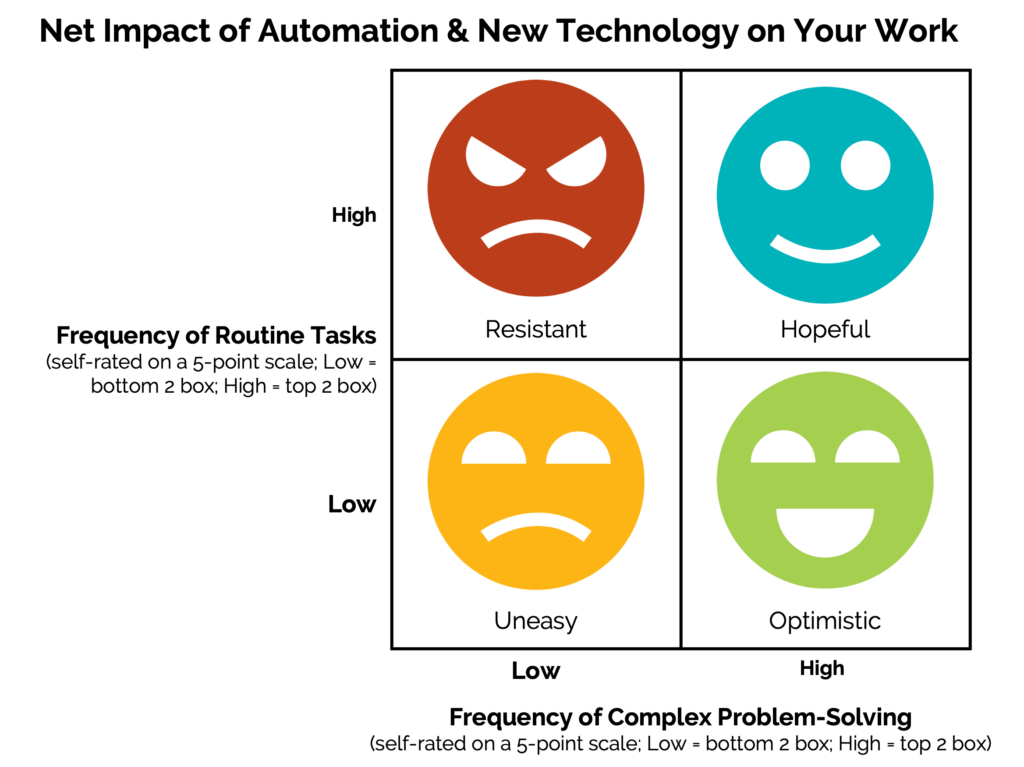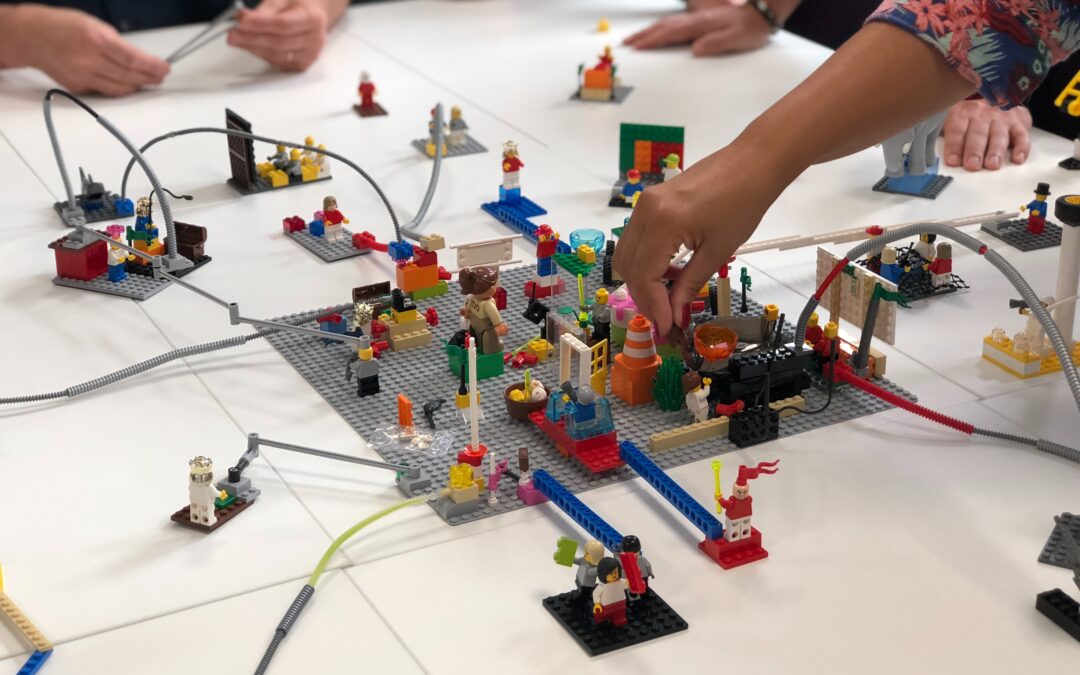
by Robyn Bolton | Aug 20, 2025 | AI, Metrics
Sometimes, you see a headline and just have to shake your head. Sometimes, you see a bunch of headlines and need to scream into a pillow. This week’s headlines on AI ROI were the latter:
- Companies are Pouring Billions Into A.I. It Has Yet to Pay Off – NYT
- MIT report: 95% of generative AI pilots at companies are failing – Forbes
- Nearly 8 in 10 companies report using gen AI – yet just as many report no significant bottom-line impact – McKinsey
AI has slipped into what Gartner calls the Trough of Disillusionment. But, for people working on pilots, it might as well be the Pit of Despair because executives are beginning to declare AI a fad and deny ever having fallen victim to its siren song.
Because they’re listening to the NYT, Forbes, and McKinsey.
And they’re wrong.
ROI Reality Check
In 20205, private investment in generative AI is expected to increase 94% to an estimated $62 billion. When you’re throwing that kind of money around, it’s natural to expect ROI ASAP.
But is it realistic?
Let’s assume Gen AI “started” (became sufficiently available to set buyer expectations and warrant allocating resources to) in late 2022/early 2023. That means that we’re expecting ROI within 2 years.
That’s not realistic. It’s delusional.
ERP systems “started” in the early 1990s, yet providers like SAP still recommend five-year ROI timeframes. Cloud Computing“started” in the early 2000s, and yet, in 2025, “48% of CEOs lack confidence in their ability to measure cloud ROI.” CRM systems’ claims of 1-3 years to ROI must be considered in the context of their 50-70% implementation failure rate.
That’s not to say we shouldn’t expect rapid results. We just need to set realistic expectations around results and timing.
Measure ROI by Speed and Magnitude of Learning
In the early days of any new technology or initiative, we don’t know what we don’t know. It takes time to experiment and learn our way to meaningful and sustainable financial ROI. And the learnings are coming fast and furious:
Trust, not tech, is your biggest challenge: MIT research across 9,000+ workers shows automation success depends more on whether your team feels valued and believes you’re invested in their growth than which AI platform you choose.
Workers who experience AI’s benefits first-hand are more likely to champion automation than those told, “trust us, you’ll love it.” Job satisfaction emerged as the second strongest indicator of technology acceptance, followed by feeling valued. If you don’t invest in earning your people’s trust, don’t invest in shiny new tech.
More users don’t lead to more impact: Companies assume that making AI available to everyone guarantees ROI. Yet of the 70% of Fortune 500 companies deploying Microsoft 365 Copilot and similar “horizontal” tools (enterprise-wide copilots and chatbots), none have seen any financial impact.
The opposite approach of deploying “vertical” function-specific tools doesn’t fare much better. In fact, less than 10% make it past the pilot stage, despite having higher potential for economic impact.
Better results require reinvention, not optimization: McKinsey found that call centers that gave agents access to passive AI tools for finding articles, summarizing tickets, and drafting emails resulted in only a 5-10% call time reduction. Centers using AI tools to automate tasks without agent initiation reduced call time by 20-40%.
Centers reinventing processes around AI agents? 60-90% reduction in call time, with 80% automatically resolved.
How to Climb Out of the Pit
Make no mistake, despite these learnings, we are in the pit of AI despair. 42% of companies are abandoning their AI initiatives. That’s up from 17% just a year ago.
But we can escape if we set the right expectations and measure ROI on learning speed and quality.
Because the real concern isn’t AI’s lack of ROI today. It’s whether you’re willing to invest in the learning process long enough to be successful tomorrow.

by Robyn Bolton | Jul 23, 2025 | Leadership, Leading Through Uncertainty, Stories & Examples
What does a lightning strike in a Spanish forest have to do with your next leadership meeting? More than you think.
On June 14, 2014, lightning struck a forest on Spain’s northeast coast, only 60 miles from Barcelona. Within hours, flames 16 to 33 feet high raced out of control toward populated areas, threatening 27,000 acres of forest, an area larger than the city of Boston.
Everything – data, instincts, decades of firefighting doctrine – prioritized saving the entire forest and protecting the coastal towns.
Instead, the fire commanders chose to deliberately let 2,057 acres, roughly the size of Manhattan’s Central Park, burn.
The result? They saved the other 25,000 acres (an area the size of San Francisco), protected the coastal communities, and created a natural firebreak that would protect the region for decades. By accepting some losses, they prevented catastrophic ones.
The Fear Trap That’s Strangling Your Business
The Tivissa fire’s triumph happened because firefighters found the courage to escape what researchers call the “fear trap” – the tendency to focus exclusively on defending against known, measurable risks.
Despite research proving that defending against predictable, measurable risks through defensive strategies consistently fails in uncertain and dynamic scenarios, firefighter “best practices” continue to advocate this approach.
Sound familiar? It should. Most executives today are trapped in exactly this pattern.
We’re in the fire right now. Financial markets are yo-yoing, AI threatens to disrupt everything, and consumer behaviors are shifting.
Most executives are falling into the Fear Trap by doubling down on protecting their existing business and pouring resources into defending against predictable risks. Yet the real threats, the ones you can’t measure or model, continue to pound the business.
While you’re protecting last quarter’s wins, tomorrow’s disruption is spreading unchecked.
Four Principles for Creative Decision-Making Under Fire
The decision to cede certain areas wasn’t hasty but based on four principles enabling leaders in any situation to successfully navigate uncertainty.
PRINCIPLE 1: A Predictable Situation is a Safe Situation. Stop trying to control the uncontrollable. Standard procedures work in predictable situations but fail in unprecedented challenges.
Put it in Practice: Instead of creating endless contingency plans, build flexibility and agility into operations and decision-making.
PRINCIPLE 2: Build Credibility Through Realistic Expectations. Reducing uncertainty requires realism about what can be achieved. Fire commanders mapped out precisely which areas around Tivissa would burn and which would be saved, then communicated these hard truths and the considered trade-offs to officials and communities before implementing their strategy, building trust and preventing panic as the selected areas burned.
Put it in practice: Stop promising to protect everything and set realistic expectations about what you can control. Then communicate priorities, expectations, and trade-offs frequently, transparently, and clearly with all key stakeholders.
PRINCIPLE 3: Include the future in your definition of success: Traditional firefighting protects immediate assets at risk. The Tivissa firefighters expanded this to include future resilience, recognizing that saving everything today could jeopardize the region tomorrow.
Put it in practice: Be transparent about how you define the Common Good in your organization, then reinforce it by making hard choices about where to compete and where to retreat. The goal isn’t to avoid all losses – it’s to maximize overall organizational health.
PRINCIPLE 4: Use uncertainty to build for tomorrow: Firefighters didn’t just accept that 2,057 acres would burn – they strategically chose which acres to let burn to create maximum future advantage, protecting the region for generations.
Put it in practice: Evaluate every response to uncertainty on whether it better positions you for future challenges. Leverage the disruption to build capabilities, market positions, and organizational structures that strengthen you for future uncertainty.
Your Next Move
When the wind shifted and the fire exploded, firefighters had to choose between defending everything (and likely losing it all) or accepting strategic losses to ensure overall wins.
You’re facing the same choice right now.
Like the firefighters, your breakthrough might come not from fighting harder against uncertainty, but from learning to work with it strategically.
What are you willing to let burn to save what matters most?

by Robyn Bolton | Mar 4, 2025 | Automation & Tech, Leadership
Imagine a manufacturing company. On the factory floor, machines whirl and grind, torches flare up as welding helmets click closed, and parts and products fall off the line and into waiting hands or boxes, ready to be shipped to customers. Elsewhere, through several doors and a long hallway, you leave the cacophony of the shop floor for the quiet hum of the office. Computers ping with new emails while fingers clickety-clack across the keyboard. Occasionally, a printer whirs to life while forcing someone to raise their voice as they talk to a customer on the other end of the phone.
Now, imagine that you ask each person whether AI and automation will positively or negatively affect their jobs. Who will champion new technology and who will resist it?
Most people expect automation acceptance to be separated by the long hallway, with the office workers welcoming while the factory workers resist.
Most people are wrong.
The Business Case for Problem-Solving Job Design
Last week, I wrote about findings from an MIT study that indicated that trust, not technology, is the leading indicator of whether workers will adopt new AI and automation tools.
But there’s more to the story than that. Researchers found that the type of work people do has a bigger influence on automation perception than where they do it. Specifically, people who engage in work requiring high levels of complex problem-solving alongside routine work are more likely to see the benefit of automation than any other group.
Or, to put it more simply

While it’s not surprising that people who perform mostly routine tasks are more resistant than those who engage in complex tasks, it is surprising that this holds true for both office-based and production-floor employees.
Even more notable, this positive perception is significantly higher for complex problem solvers vs. the average across all workers::
- Safety: 43% and 41% net positive for office and physical workers, respectively (vs. 32% avg)
- Pay: 27% and 25% net positive for physical and office workers, respectively (vs. 3.9% avg)
- Autonomy: 33% net positive for office workers (vs. 18% average)
- Job security: 25% and 22% net positive for office and physical workers, respectively (vs. 3.5%)
Or, to put it more simply, blend problem-solving into routine-heavy roles, and you’ll transform potential technology resistors into champions.
3 Ways to Build Problem-Solving Into Any Role
The importance of incorporating problem-solving into every job isn’t just a theory – it’s one of the core principles of the Toyota Production System (TPS). Jidoka, or the union of automation with human intelligence, is best exemplified by the andon cord system, where employees can stop manufacturing if they perceive a quality issue.
But you don’t need to be a Six-Sigma black belt to build human intelligence into each role:
- Create troubleshooting teams with decision authority
Workers who actively diagnose and fix process issues develop a nuanced understanding of where technology helps versus hinders. Cross-functional troubleshooting creates the perfect conditions for technology champions to emerge.
- Design financial incentives around problem resolution
The MIT study’s embedded experiment showed that financial incentives significantly improved workers’ perception of new technologies while opportunities for input alone did not. When workers see personal benefit in solving problems with technology, adoption accelerates.
- Establish learning pathways connected to problem complexity
Workers motivated by career growth (+33.9% positive view on automation’s impact on upward mobility) actively seek out technologies that help them tackle increasingly complex problems. Create visible advancement paths tied to problem-solving mastery.
Innovation’s Human Catalyst
The most powerful lever for technology adoption isn’t better technology—it’s better job design. By restructuring roles to include meaningful problem-solving, you transform the innovation equation.
So here’s the million-dollar question every executive should be asking: Are you designing jobs that create automation champions, or are you merely automating jobs as they currently exist?

by Robyn Bolton | Feb 18, 2025 | Innovation, Leadership, Metrics, Tips, Tricks, & Tools
Innovation is undergoing a metamorphosis, and while it may seem like the current goo-stage is the hard part (it’s certainly not easy!), our greatest challenge is still ahead. Because while we may emerge as beautiful butterflies, we still need to get buy-in for change from a colony of skeptical caterpillars who’ve grown weary of transformation talk.
The Old Playbook Is Dead, Too
Picture this: A butterfly lands, armed with PowerPoint slides about “The Future of Leaf-Eating” and projections showing “10x Nectar Collection Potential.” The caterpillars stare blankly, having seen this show before.
The old approach – big presentations, executive sponsorship, and promises of massive returns within 24 months – isn’t just ineffective. It’s harmful. Each failed transformation makes the next one harder, turning your caterpillars more cynical and more determined to cling to their leaves.
The Secret Most Change Experts Miss
Butterflies don’t convince caterpillars to transform by showing off their wings. They create conditions where transformation feels possible, necessary, and safe. Your job isn’t to sell the end state – it’s to help others see their own potential for change.
Here’s how:
Start With the Hungriest Caterpillars
Find those who feel the limitations of their current state most acutely. They’re not satisfied with their current leaf, and they’re curious about what lies beyond. These early adopters become your first chrysalis cohort.
Make it About Their Problems, Not Your Vision
Instead of talking about transformation, focus on specific pain points. “Wouldn’t it be easier to reach that juicy leaf if you could fly?” is more compelling than “Flying represents a paradigm shift in leaf acquisition strategy.”
Build a Network of Proof
Every successful mini-transformation creates evidence that change is possible. When one caterpillar successfully navigates their chrysalis phase, others pay attention. Let your transformed allies tell their stories.
Set Realistic Expectations
Metamorphosis takes time and isn’t always pretty. Be honest about the goo phase – that messy middle where things fall apart before they come together. This builds trust and prepares people for the real journey, not the sanitized version.
Where to Start
- Identify your first chrysalis cohort – the people already feeling the limits of their current state
- Focus on solving immediate problems that showcase the benefits of change
- Document and share small victories, letting others tell their transformation stories
- Create realistic timelines that acknowledge both quick wins and longer-term metamorphosis
What’s your experience? Have you successfully guided a transformation without relying on buzzwords and fancy presentations? Drop your stories in the comments.
After all, we’re all just caterpillars and butterflies helping each other find our wings.

by Robyn Bolton | Jul 29, 2020 | Customer Centricity, Innovation, Strategy
Over the past several weeks, I’ve kicked off innovation projects with multiple clients. As usual, my clients are deeply engaged and enthusiastic, eager to learn how to finally break through the barriers their organizations erect and turn their ideas into real initiatives that generate real results.
Things were progressing smoothly during the first kick-off until a client asked, “Who’s my customer?”
I was shocked. Dumbfounded. Speechless. To me, someone who “grew up” in P&G’s famed brand management function and who has made career out of customer-driven innovation, this was the equivalent of asking, “why should I wear clothes?” The answer is so obvious that the question shouldn’t need to be asked.
Taking a deep breath, I answered the question and we moved on.
A few days later, the question was asked again. By a different client. In a different company. A few days later, it was asked a third time. By yet a different client. In yet a different company. In a completely different industry!
What was going on?!?!?
Each time I gave an answer specific to the problem we were working to solve. When pressed, I tried to give a general definition for “customer” but found that I spent more time talking about exceptions and additions to the definition rather than giving a concise, concrete, and usable answer.
That’s when it struck me – Being “customer-driven” isn’t enough. To be successful, especially in innovation, you need to focus on serving everyone involved in your solution. You need to be “stakeholder-driven.”
What is a customer?
According to Merriam-Webster, a customer is “one that purchases a commodity or service.”
Makes perfect sense. At P&G, we referred to retailers like WalMart and Kroger as “customers” because they purchased P&G’s products from the company. These retailers then sold P&G’s goods to “consumers” who used the products.
But P&G didn’t focus solely on serving its customers. Nor did it focus solely on serving its consumers. It focused on serving both because to serve only one would mean disaster for the long-term business. It focused on its stakeholders.
What is a stakeholder?
Setting aside Merriam-Webster’s first definition (which is specific to betting), the definitions of a stakeholder are “one that has a stake in an enterprise” and “one who is involved in or affected by a course of action.”
For P&G, both customers (retailers) and consumers (people) are stakeholders because they are “involved in or affected by” P&G’s actions. Additionally, shareholders and employees are stakeholders because they have a “stake in (the) enterprise.”
As a result, P&G is actually a “stakeholder-driven” company in which, as former CEO AG Lafley said in 2008, the “consumer is boss.”
How to be a stakeholder-driven organization
Focusing solely on customers is a dangerous game because it means that other stakeholders who are critical to your organization’s success may not get their needs met and, as a result, may stop supporting your work.
Instead, you need to understand, prioritize, and serve all of your stakeholders
Here’s how to do that:
- Identify ALL of your stakeholders. Think broadly, considering ALL the people inside and outside your organization who have a stake or are involved or affected by your work.
- Inside your organization: Who are the people who need to approve your work? Who will fund it? Who influences these decisions? Who will be involved in bringing your solution to life? Who will use it? Who could act as a barrier to any or all of these things?
- Outside your organization: Who will pay for your solution? Who will use your solution? Who influences these decisions? Who could act as a barrier?
- Talk to your stakeholders and understand what motivates them. For each of the people you identify by asking the above questions, take time to actually go talk to them – don’t email them, don’t send a survey, actually go have a conversation – and seek to understand they’re point of view. What are the biggest challenges they are facing? Why is this challenging? What is preventing them from solving it? What motivates them, including incentives and metrics they need to deliver against? What would get them to embrace a solution? What would cause them to reject a solution?
- Map points of agreement and difference amongst your stakeholder. Take a step back and consider all the insights from all of your stakeholders. What are the common views, priorities, incentives, or barriers? What are the disagreements or points of tension? For example, do your buyers prioritize paying a low price over delivering best-in-class performance while your users prioritize performance over price? Are there priorities or barriers that, even though they’re unique to a single stakeholder, you must address?
- Prioritize your stakeholder by answering, “Who’s the boss?” Just as AG Lafley put a clear stake in the ground when he declared that, amongst all of P&G’s stakeholders, that the consumer was boss, challenge yourself to identify the “boss” for your work. For medical device companies, perhaps “the boss” is the surgeon who uses the device and the hospital executive who has the power to approve the purchase. For a non-profit, perhaps it’s the donors who contribute a majority of the operating budget. For an intrapreneur working to improve an internal process, perhaps it’s the person who is responsible for managing the process once it’s implemented. To be clear, you don’t focus on “the boss” to the exclusion of the other stakeholders but you do prioritize serving the boss.
- Create an action plan for each stakeholder. Once you’ve spent time mapping, understanding, and prioritizing the full landscape of your stakeholder’s problems, priorities, and challenges, create a plan to address each one. Some plans may focus on the design, features, functions, manufacturing, and other elements of your solution. Some plans may focus on the timing and content of proactive communication. And some plans may simply outline how to respond to questions or a negative incident.
Yes, it’s important to understand and serve your customers. But doing so is insufficient for long-term success. Identifying, understanding, and serving all of your stakeholders is required for long-term sustainability.
Next time you start a project, don’t just ask “Who is my customer?” as “Who are my stakeholders?” The answers my surprise you. Putting those answers into action through the solutions you create and the results they produce will delight you.
Originally published on March 23, 2020 on Forbes.com





